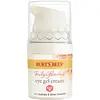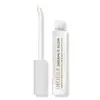What's inside
What's inside
 Key Ingredients
Key Ingredients

 Benefits
Benefits

 Concerns
Concerns

 Ingredients Side-by-side
Ingredients Side-by-side

Water
Skin ConditioningGlycerin
HumectantMango Butter Dimer Dilinoleyl Esters/Dimer Dilinoleate Copolymer
EmollientBentonite
AbsorbentCaprylic/Capric Triglyceride
MaskingUndecane
EmollientC10-18 Triglycerides
EmollientBeeswax
Emulsion StabilisingInulin
Skin ConditioningSqualane
EmollientCandelilla/Jojoba/Rice Bran Polyglyceryl-3 Esters
EmulsifyingGlyceryl Stearate
EmollientTridecane
PerfumingCarthamus Tinctorius Seed Oil
MaskingSimmondsia Chinensis Seed Oil
EmollientHydrolyzed Hyaluronic Acid
HumectantCetearyl Alcohol
EmollientSodium Stearoyl Lactylate
EmulsifyingSilica
AbrasiveTocopherol
AntioxidantSodium PCA
HumectantXanthan Gum
EmulsifyingParfum
MaskingCitric Acid
BufferingPotassium Sorbate
PreservativeLecithin
EmollientSclerotium Gum
Emulsion StabilisingSodium Phytate
Pullulan
Alcohol
AntimicrobialPhenoxyethanol
PreservativeEthyl Lauroyl Arginate Hcl
Skin ConditioningWater, Glycerin, Mango Butter Dimer Dilinoleyl Esters/Dimer Dilinoleate Copolymer, Bentonite, Caprylic/Capric Triglyceride, Undecane, C10-18 Triglycerides, Beeswax, Inulin, Squalane, Candelilla/Jojoba/Rice Bran Polyglyceryl-3 Esters, Glyceryl Stearate, Tridecane, Carthamus Tinctorius Seed Oil, Simmondsia Chinensis Seed Oil, Hydrolyzed Hyaluronic Acid, Cetearyl Alcohol, Sodium Stearoyl Lactylate, Silica, Tocopherol, Sodium PCA, Xanthan Gum, Parfum, Citric Acid, Potassium Sorbate, Lecithin, Sclerotium Gum, Sodium Phytate, Pullulan, Alcohol, Phenoxyethanol, Ethyl Lauroyl Arginate Hcl
Water
Skin ConditioningGlycerin
HumectantButyrospermum Parkii Butter
Skin ConditioningGlyceryl Stearate Citrate
EmollientTitanium Dioxide
Cosmetic ColorantMica
Cosmetic ColorantHelianthus Annuus Seed Wax
Skin ConditioningSilica
AbrasivePolyglyceryl-3 Stearate
EmulsifyingSodium PCA
HumectantSimmondsia Chinensis Seed Oil
EmollientSr-Hydrozoan Polypeptide-1
HumectantAdansonia Digitata Seed Oil
EmollientOlea Europaea Oil Unsaponifiables
Skin ConditioningHydrogenated Lecithin
EmulsifyingShorea Robusta Resin
TonicRhus Verniciflua Peel Wax
Opuntia Ficus-Indica Seed Oil
EmollientTocopherol
AntioxidantSodium Hyaluronate
HumectantXanthan Gum
EmulsifyingGlyceryl Stearate
EmollientPolyglyceryl-2 Stearate
EmulsifyingStearyl Alcohol
EmollientPhenoxyethanol
PreservativeEthylhexylglycerin
Skin ConditioningTin Oxide
AbrasiveCitric Acid
BufferingWater, Glycerin, Butyrospermum Parkii Butter, Glyceryl Stearate Citrate, Titanium Dioxide, Mica, Helianthus Annuus Seed Wax, Silica, Polyglyceryl-3 Stearate, Sodium PCA, Simmondsia Chinensis Seed Oil, Sr-Hydrozoan Polypeptide-1, Adansonia Digitata Seed Oil, Olea Europaea Oil Unsaponifiables, Hydrogenated Lecithin, Shorea Robusta Resin, Rhus Verniciflua Peel Wax, Opuntia Ficus-Indica Seed Oil, Tocopherol, Sodium Hyaluronate, Xanthan Gum, Glyceryl Stearate, Polyglyceryl-2 Stearate, Stearyl Alcohol, Phenoxyethanol, Ethylhexylglycerin, Tin Oxide, Citric Acid
Ingredients Explained
These ingredients are found in both products.
Ingredients higher up in an ingredient list are typically present in a larger amount.
Citric Acid is an alpha hydroxy acid (AHA) naturally found in citrus fruits like oranges, lemons, and limes.
Like other AHAs, citric acid can exfoliate skin by breaking down the bonds that hold dead skin cells together. This helps reveal smoother and brighter skin underneath.
However, this exfoliating effect only happens at high concentrations (20%) which can be hard to find in cosmetic products.
Due to this, citric acid is usually included in small amounts as a pH adjuster. This helps keep products slightly more acidic and compatible with skin's natural pH.
In skincare formulas, citric acid can:
While it can provide some skin benefits, research shows lactic acid and glycolic acid are generally more effective and less irritating exfoliants.
Most citric acid used in skincare today is made by fermenting sugars (usually from molasses). This synthetic version is identical to the natural citrus form but easier to stabilize and use in formulations.
Read more about some other popular AHA's here:
Learn more about Citric AcidGlycerin is already naturally found in your skin. It helps moisturize and protect your skin.
A study from 2016 found glycerin to be more effective as a humectant than AHAs and hyaluronic acid.
As a humectant, it helps the skin stay hydrated by pulling moisture to your skin. The low molecular weight of glycerin allows it to pull moisture into the deeper layers of your skin.
Hydrated skin improves your skin barrier; Your skin barrier helps protect against irritants and bacteria.
Glycerin has also been found to have antimicrobial and antiviral properties. Due to these properties, glycerin is often used in wound and burn treatments.
In cosmetics, glycerin is usually derived from plants such as soybean or palm. However, it can also be sourced from animals, such as tallow or animal fat.
This ingredient is organic, colorless, odorless, and non-toxic.
Glycerin is the name for this ingredient in American English. British English uses Glycerol/Glycerine.
Learn more about GlycerinGlyceryl Stearate is a mix of glycerin and stearic acid.
It is used to stabilize the mixing of water and oil ingredients. By preventing these ingredients from separating, it can help elongate shelf life. It can also help thicken the product's texture.
As an emollient, it helps soften skin and supports barrier-replenishing ingredients.
In cosmetics, Glyceryl Stearate is often made from vegetable oils or synthetically produced.
This ingredient may not be fungal-acne safe
Fun fact: The human body also creates Glyceryl Stearate naturally.
Learn more about Glyceryl StearatePhenoxyethanol is a preservative that has germicide, antimicrobial, and aromatic properties. Studies show that phenoxyethanol can prevent microbial growth. By itself, it has a scent that is similar to that of a rose.
It's often used in formulations along with Caprylyl Glycol to preserve the shelf life of products.
Silica, also known as silicon dioxide, is a naturally occurring mineral. It is used as a fine, spherical, and porous powder in cosmetics.
Though it has exfoliant properties, the function of silica varies depending on the product.
The unique structure of silica enhances the spreadability and adds smoothness, making it a great texture enhancer.
It is also used as an active carrier, emulsifier, and mattifier due to its ability to absorb excess oil.
In some products, tiny microneedles called spicules are made from silica or hydrolyzed sponge. When you rub them in, they lightly polish away dead skin layers and enhance the penetration of active ingredients.
Learn more about SilicaThis oil comes from the seeds of the desert shrub called Jojoba. It is more commonly known as jojoba oil, a non-comedogenic oil.
Jojoba oil does not contain fragrance and has many fatty-acids, making it a great soothing ingredient.
It also contains Vitamin E, a great moisturizing ingredient. Vitamin E is also an antioxidant and protects your skin against oxidative damage.
This ingredient humectant properties, meaning it helps draw moisture from the air. This helps keep your skin hydrated.
While jojoba has antibacterial properties, it is only able to kill some strains of bacteria.
Studies also show it helps in wound healing. In fact, Indigenous cultures have used jojoba as a moisturizer and to help treat burns for centuries.
Fun fact: Jojoba oil similar to natural human skin sebum, so it has a great effect on dry skin. It is also promising with helping to regulate sebum production.
Due to its fatty acid content, Jojoba oil may not be fungal acne safe. We recommend speaking with a professional if you have any concerns.
Learn more about Simmondsia Chinensis Seed OilSodium PCA is the sodium salt of pyroglutamic acid. It is naturally occurring in our skin's natural moisturizing factors where it works to maintain hydration.
The PCA stands for pyrrolidone carboxylic acid, a natural amino acid derivative.
This ingredient has skin conditioning, anti-inflammatory, and humectant properties. Humectants help hydrate your skin by drawing moisture from the air. This helps keep your skin moisturized.
Learn more about Sodium PCATocopherol (also known as Vitamin E) is a common antioxidant used to help protect the skin from free-radicals and strengthen the skin barrier. It's also fat soluble - this means our skin is great at absorbing it.
Vitamin E also helps keep your natural skin lipids healthy. Your lipid skin barrier naturally consists of lipids, ceramides, and fatty acids. Vitamin E offers extra protection for your skin’s lipid barrier, keeping your skin healthy and nourished.
Another benefit is a bit of UV protection. Vitamin E helps reduce the damage caused by UVB rays. (It should not replace your sunscreen). Combining it with Vitamin C can decrease sunburned cells and hyperpigmentation after UV exposure.
You might have noticed Vitamin E + C often paired together. This is because it is great at stabilizing Vitamin C. Using the two together helps increase the effectiveness of both ingredients.
There are often claims that Vitamin E can reduce/prevent scarring, but these claims haven't been confirmed by scientific research.
Learn more about TocopherolWater. It's the most common cosmetic ingredient of all. You'll usually see it at the top of ingredient lists, meaning that it makes up the largest part of the product.
So why is it so popular? Water most often acts as a solvent - this means that it helps dissolve other ingredients into the formulation.
You'll also recognize water as that liquid we all need to stay alive. If you see this, drink a glass of water. Stay hydrated!
Learn more about WaterXanthan gum is used as a stabilizer and thickener within cosmetic products. It helps give products a sticky, thick feeling - preventing them from being too runny.
On the technical side of things, xanthan gum is a polysaccharide - a combination consisting of multiple sugar molecules bonded together.
Xanthan gum is a pretty common and great ingredient. It is a natural, non-toxic, non-irritating ingredient that is also commonly used in food products.
Learn more about Xanthan Gum